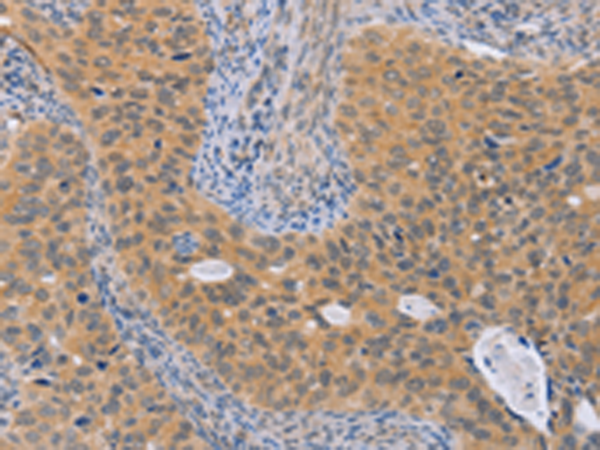


| WB | 1/1000 | Human,Mouse,Rat |
| IF | 咨询技术 | Human,Mouse,Rat |
| IHC | 咨询技术 | Human,Mouse,Rat |
| ICC | 技术咨询 | Human,Mouse,Rat |
| FCM | 咨询技术 | Human,Mouse,Rat |
| Elisa | 咨询技术 | Human,Mouse,Rat |
| WB Predicted band size | 44 kDa |
| Host/Isotype | Rabbit IgG |
| Antibody Type | Primary antibody |
| Storage | Store at 4°C short term. Aliquot and store at -20°C long term. Avoid freeze/thaw cycles. |
| Species Reactivity | Human, Mouse, Rat |
| Immunogen | Synthetic peptide of human BRS3 |
| Formulation | Purified antibody in PBS with 0.05% sodium azide and 50% glycerol. |
+ +
以下是关于KCNB2(N-term)抗体的示例参考文献(注:以下内容为示例性质,具体文献可能需要通过学术数据库进一步验证):
---
1. **文献名称**: "Voltage-gated potassium channel KCNB2 in neurodevelopmental disorders: Antibody validation and expression profiling"
**作者**: Johnson, R. et al.
**摘要**: 本研究验证了KCNB2(N-term)抗体的特异性,通过免疫印迹和免疫组化证实其在人脑组织中的表达模式,发现KCNB2在发育期大脑皮层神经元中高表达,提示其与神经发育障碍的潜在关联。
2. **文献名称**: "Structural insights into the N-terminal domain of KCNB2 and its role in channel modulation"
**作者**: Chen, L. & Wang, H.
**摘要**: 利用KCNB2(N-term)抗体进行共聚焦显微镜和蛋白质相互作用实验,揭示了KCNB2的N端结构域在调控通道门控动力学中的关键作用,并发现其与钙调蛋白的结合机制。
3. **文献名称**: "Altered KCNB2 expression in temporal lobe epilepsy: A Western blot and immunohistochemical study"
**作者**: Martínez, S. et al.
**摘要**: 通过KCNB2(N-term)抗体检测癫痫患者脑组织中KCNB2的表达变化,发现其在海马区的表达显著下调,提示KCNB2可能通过调节神经元兴奋性参与癫痫病理过程。
4. **文献名称**: "KCNB2 antibody characterization for synaptic protein network analysis in autism spectrum disorder models"
**作者**: Kim, Y. et al.
**摘要**: 该研究利用KCNB2(N-term)抗体结合质谱技术,在小鼠自闭症模型中鉴定出KCNB2与突触后蛋白的相互作用网络,为理解其功能提供了新视角。
---
如需具体文献,建议通过PubMed或Google Scholar检索关键词“KCNB2 antibody N-terminal”或联系抗体供应商获取相关技术文档。
The KCNB2 (N-term) antibody is a specialized immunological tool designed to target the N-terminal region of the KCNB2 protein, encoded by the *KCNB2* gene. KCNB2 belongs to the voltage-gated potassium (Kv) channel family, specifically the Shab-related subfamily, which forms delayed rectifier potassium channels. These channels play critical roles in regulating neuronal excitability and action potential repolarization by mediating potassium efflux in response to membrane depolarization. The KCNB2 subunit contains six transmembrane domains and assembles into tetramers, often co-expressing with auxiliary subunits to modulate channel kinetics and trafficking.
The N-terminal domain of KCNB2 is located intracellularly and contributes to channel assembly, trafficking, and interaction with regulatory proteins. Antibodies targeting this region are essential for studying KCNB2 expression, localization, and functional regulation in physiological and pathological contexts. They are widely used in techniques such as Western blotting, immunohistochemistry, and immunofluorescence to investigate KCNB2 distribution in brain tissues, where it is predominantly expressed in neurons, particularly in the hippocampus, cortex, and cerebellum.
Research leveraging the KCNB2 (N-term) antibody has linked KCNB2 dysfunction to neurological disorders, including epilepsy, autism spectrum disorders, and schizophrenia, as well as potential roles in cancer progression. Validated for specificity, this antibody helps distinguish KCNB2 from closely related channels like KCNB1. aiding mechanistic studies of Kv channel biology and disease-associated mutations. Its applications extend to drug discovery and biomarker development targeting potassium channelopathies.
×